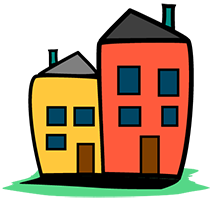The wider your network of community partners the more opportunities you will have for funding projects. This is why identifying and building your home usability resource network is so important. The services that are currently available in your community will determine the routes you take to funding consumer home usability projects.
Funding strategies
Here we will focus on two main types of funding strategies. However, this is just a place to start! Use the discussion boards to share what has worked in your community and connect with others who are doing similar work.
Developing a funding pool
One strategy for funding home usability is to develop a funding stream through your CIL. This strategy gives you more control over how funds are used and the process and procedures for distributing funds and paying for home usability programs. Here are some strategies and funding sources to explore:
- Community Development Block Grants (CDBG) are grants that are distributed via the Department of Housing and Urban Development (HUD) to support the housing needs of communities.
- Housing Trust Funds are programs developed through local governments to help support community specific housing needs. Many communities distribute funding via grants to local organizations
- For example, Independence Inc in Lawrence KS uses City Housing Trust Fund dollars to fund their home access program
-
- Area Agencies on Aging
- This report highlights some of the home modification work AAAs do
- Placer Independent Resource Services (PIRS) a CA based CIL works with their AAA to provide home mods to consumers over 60.
- United Way
- Community Development Corporations (CDCs)
- Work with your SILC (State Independent Living Council)
- Area Agencies on Aging
Patchwork funding based on needs
Another strategy for funding home usability needs is to work individually with the consumers to identify their needs and what community resources are available to help support them. This strategy may be limited by the resources that are available in your community. However, this route provides opportunities to work with consumers to develop their own personal usability networks and self advocacy skills.
- Developing your community resource list is an excellent way to identify what home modification and assistive technology programs already serve your area.
- Local furniture and medical supply stores may be interested in donating items or working with consumers to structure payment plans
- Seek out relationships with local hardware stores and contractors to receive donations/discounts
- Some CILs have identified that its valuable to have a handyman/building professional on staff!
- Does your community have a Habitat for Humanity ReStore, or another locally operated materials reuse center? This is a great way to access low cost materials and connect with skilled individuals
- Local thrift stores and donation warehouses may be willing to set aside items and notify you when something is available
- Use Amazon charities lists and fundraisers to fund raise and reach out to the community about consumer’s needs
Resources
This resource from the Leonard Davis School of Gerontology at the University of Southern California has many resources and suggestions for consumers and organizations, check it out at Homemods.org
The National Council on Independent Living (NCIL), in partnership with RTC:PICL, developed a factsheet highlighting how CILs run home modification, access and usability programs at their center.
The Administration on Community Living, a federal agency focused on supporting people with disabilities and older adults living in the community, has a webinar series on successful strategies and partnerships to help support housing stability.
ILRU (Independent Living Resource Utilization) program is a national center for information, training, research, and technical assistance in independent living. They have trainings and resources on supporting community based housing work for CILS.
Check out our Funding Resources Page for more!
